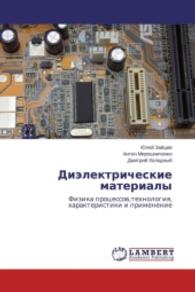- ホーム
- > 洋書
- > 英文書
- > Nature / Ecology
Contents
Contents
Preface
1 Introduction
1.1 Challenges in Irrigation and a Need for Innovation
1.2 Current Advances and Unresolved Challenges
1.3 Objectives and Organization of the Book
2 Background on Soil Moisture Modeling
2.1 Introduction
2.2 Water Content
2.3 Energy Status of Soil Water
2.4 Soil Water Retention Curve
2.5 Darcy's Law
2.6 Richards Equation
2.6.1 Solution of the Richards Equation
2.6.2 Sink Term
2.7 The General Form of the Richards Equation
2.8 Conclusion
3 Background on Machine Learning and Model Predictive Control
3.1 Machine Learning
3.1.1 Supervised Machine Learning
3.1.2 Unsupervised Machine Learning
3.1.3 Reinforcement Learning
3.2 Model Predictive Control
3.2.1 Formation of MPC
3.2.2 Solving MPC
3.2.3 Feasibility of MPC
3.2.4 Tuning of MPC
3.3 Conclusion
4 Soil Moisture and Hydraulic Parameter Estimation in Agro- Hydrological Systems
4.1 Introduction
4.2 Model Development
4.3 Sensitivity Analysis for Parameter Estimability
4.3.1 Output Sensitivity Matrix for Spatially Varying Measurements
4.4 Parameter Selection through Orthogonal Projection
4.5 EKF Design
4.6 Simulated Case Study
4.6.1 Simulation Results
4.7 Real Case Study
4.7.1 Study Site and Microwave Sensor Configuration
4.7.2 Numerical Representation of the Study Site
4.7.3 Sensor Data Preprocessing
4.7.4 Analysis of Parameter Estimability and Selection Studies
4.7.5 Estimator Design
4.7.6 Evaluation Criteria
4.7.7 Experimental Results and Discussion
4.8 Conclusion
5 Adaptive Soil Moisture Estimation Using Performance-Triggered
Model Reduction
5.1 Introduction
5.2 Model Development and Problem Statement
5.3 Model Reduction and Estimation Scheme
5.3.1 Adaptive Structure-Preserving Model Reduction
Step : Generation of State Trajectories
Step : Cluster-Based Model Reduction
5.3.2 Reduced-Order Adaptive EKF
5.3.3 Error Metric and Implementation Algorithm
5.4 Field Implementation of the Proposed Framework
5.4.1 Results and Discussion
5.4.2 Simulation Time Comparison Across Estimation Schemes
5.5 Conclusion
6 Mixed-Integer Model Predictive Control for Irrigation Scheduling
6.1 Introduction
6.2 Daily Irrigation Scheduling under Uniform Field Conditions
6.2.1 Soil Moisture Model Development
6.2.2 Surrogate Model Development
6.2.3 Scheduler Formulation
6.2.4 Case Study
6.3 Irrigation Scheduling in Spatially Heterogeneous Fields
6.3.1 Soil Moisture Modeling
6.3.2 Scheduler Formulation
6.3.3 Case Study
6.4 Conclusion
7 Multi-Agent MPC for Irrigation Scheduling: A Learning-Based Approach
7.1 Introduction
7.2 Three-Stage Process for Management Zone (MZ) Delineation
7.3 LSTM-Based Modeling of Soil Moisture
7.3.1 Richards Equation
7.3.2 Training Data Generation
7.3.3 Model Design
7.4 Mixed-integer MPC with Zone Control for Irrigation Scheduling
7.5 Decentralized Hybrid Actor-Critic Agents and the Role of a Limiting MZ
7.5.1 Agent Design and Training
7.5.2 Multi-Agent MPC Paradigm
7.5.3 Triggered Irrigation Scheduling
7.6 Application to a Large-Scale Field
7.6.1 Delineation of MZs in the Study Area
7.6.2 LSTM Network Training for Quadrant
7.6.3 Implementation of Hybrid PPO Agents in Quadrant
7.6.4 Implementation of Proposed and Triggered Schedulers in Quadrant
7.6.5 Results and Discussion
7.6.6 Evaluation of the Proposed Scheduler's Effectiveness
7.7 Conclusion
8 Optimizing Irrigation with Semi-Centralized Multi-Agent RL195
8.1 Introduction
8.2 Semi-Centralized MARL (SCMARL) Framework
8.2.1 Addressing Non-Stationarity in SCMARL Frameworks
8.2.2 Design of Local Agents
8.2.3 Design of the Coordinator Agent
8.3 Field-Scale Implementation of the SCMARL Framework
8.3.1 Simulation Environment Configuration
8.3.2 Agent Setup and Training Process
8.3.3 Learning Outcomes of Agents
8.4 Evaluation of SCMARL
8.4.1 Evaluation of the State Augmentation Strategy
8.4.2 Local Agent Policy Alignment with Coordinator
8.4.3 SCMARL vs Decentralized MARL: A Comparative Study
8.4.4 Results and Discussion
8.4.5 Impact of State Augmentation on Agent Performance
8.4.6 Local Agents' Policy Agreement with Coordinator's Action
8.4.7 Assessment of SCMARL Performance and Utility
8.5 Conclusion
9 Integrating Daily Scheduling and Hourly Control for Precision Irrigation
9.1 Introduction
9.2 Observer-Based SCMARL Scheduler
9.2.1 POMDP Setting
9.2.2 EKF for Belief State Estimation
9.2.3 Belief State-Based Reward Functions
9.3 Advanced Controller Design
9.4 Observer-Based SCMARL Implementation
9.4.1 Environment Configuration and Training
9.4.2 Learning Outcomes of Observer-Based SCMARL Agents
9.5 Field Implementation of the Integrated Scheduling and Control Layers
9.5.1 Results and Discussion
9.6 Conclusion
10 Future Directions
10.1 Advancing Soil Moisture and Hydraulic Parameter Estimation
10.2 Advancing the Design of Multi-Agent MPC-Based Schedulers
10.3 Advancing Semi-Centralized Multi-Agent RL Applications
10.4 Advancing the Integration of Scheduling and Control
A Relevant Crop and Weather Data
A.1 Case Studies of Chapters and
A.2 Case Studies of Chapter
A.3 Temperature and Evapotranspiration for Case Studies of Chapters7,8,and 9
A.4 Crop Coefficient Relations
A.4.1 Barley
A.4.2 Spring Soft Wheat
B Relevant Soil Hydraulic Parameters
B.1 Nominal Parameter Maps Used in Sensitivity Analysis
B.2 Soil Parameters Used in Validation of Chapter
C Crop Yield Calculations
D Extended Kalman Filter Design
E Relevant Parameters and Simulation Setup
E.1 Richards Equation
E.2 LSTM Network
E.3 Hybrid PPO Agent
E.4 Parameters and Weights








